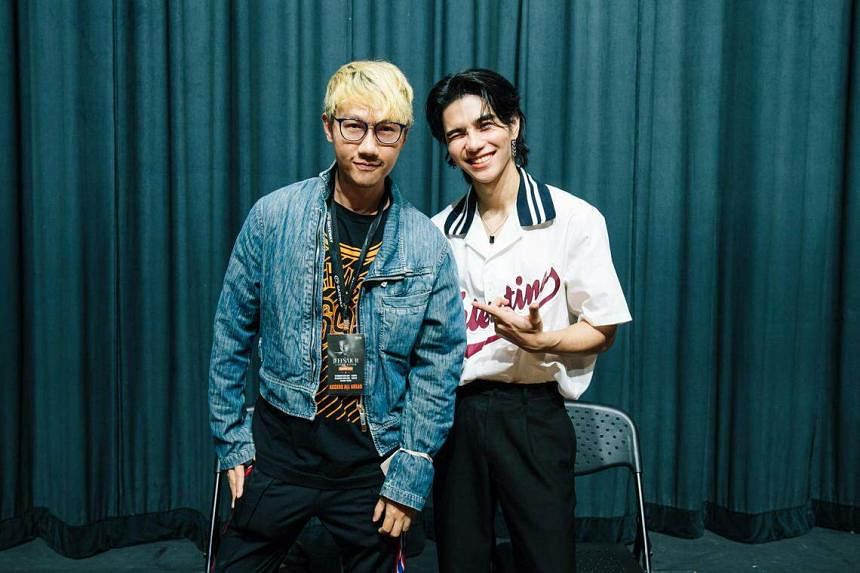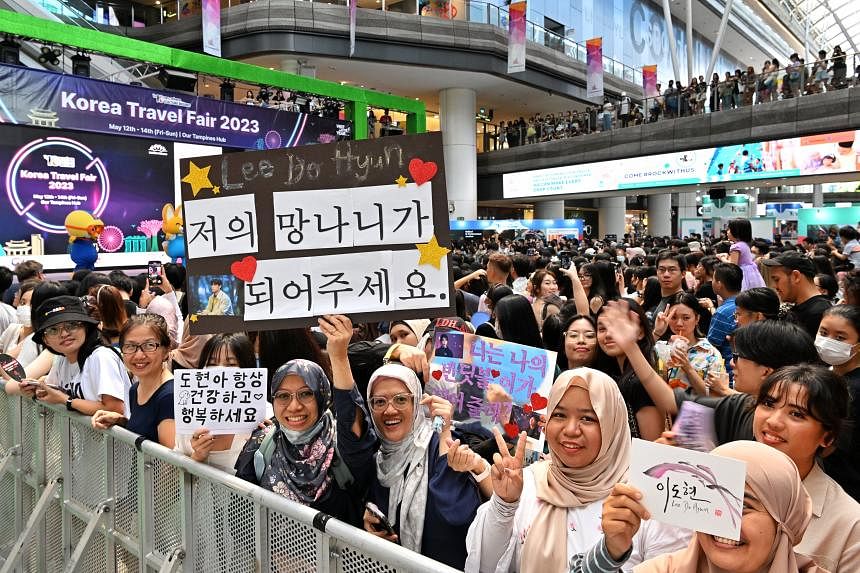When legal adviser Anne Ho fell in love with South Korean actor Ryu Si-won while watching his performance in the drama Beautiful Days in 2001, little did she realise it would develop into a full-blown love affair with all things Korean.
From South Korean dramas, she moved on to become a fan of South Korean variety shows, and is today a follower of K-pop group Winner.
Along the way, Ms Ho picked up the Korean language, grew to love spicy Korean cuisine, travelled to South Korea frequently, and even started to explore business opportunities there.
Her passion for Korean culture led her to widen her social circle, said Ms Ho, 50, a Malaysian who lives in Hong Kong. “It’s the friendships I’ve built over the years that have kept me going.”
Her journey is typical of many long-time K-fans and bears testament to how the Korean Wave has evolved since romantic TV drama Winter Sonata took Asia by storm in 2002.
South Korean pop culture has since expanded beyond Asian shores to become a global phenomenon, fuelled by the advent of social media, mobile phone technology and online streaming.
The export of South Korea’s cultural contents – defined as anything from music to drama, films, games, animation and webtoons – reached an all-time high of US$12.4 billion (S$16.9 billion) in 2021, according to official figures released in 2023.
This accounted for 1.92 per cent of South Korea’s total exports of US$644.5 billion. The figure is higher than for home appliances at US$8.7 billion, and rechargeable batteries, also at US$8.7 billion.
Observers say hard work, shrewd investment, sleek marketing and non-stop innovation by both the industry and the government lie behind this phenomenon, which doesn’t appear to be dying any time soon.
How did the culture of South Korea, a nation of 51.7 million people, become so popular?
Mr James Kang, chief executive of Singapore’s Mode Entertainment, which manages artistes and organises concerts, described the K-wave as a “stoic success story about identity”.
“The South Korean strategy for world domination is a lethal combination of meticulous preparation, persistence, ambition and hard work,” said the Singaporean industry veteran who has handled promotions for top South Korean singer BoA and pop groups Big Bang and Shinee.
The Korean Wave is not a duplicate or sampling of American culture, Mr Kang noted. “K-pop is still largely sung in Korean, produced by Koreans with a unique sound, with fierce stylised dance choreography that the West had not experienced before.”
Journalist-turned-professor Jin Dal-yong of Simon Fraser University in Canada attributed the K-wave to talented and dedicated producers, directors, writers and composers, the timely growth of necessary infrastructure, and the government’s supportive cultural policies.
The entertainment industry is also able to keep churning out new growth engines to overcome stagnation and decline, Prof Jin, who has written books about the Korean Wave, told The Straits Times.
He pointed out how K-pop stepped in when K-dramas and films began to feel tired, and how webtoons are now the big thing.
“Fortuitous timing” played a crucial role too, said sociology professor Shin Gi-wook of Stanford University, who has written books about South Korea.
He noted how South Korean dramas started proliferating on streaming platform Netflix shortly before the Covid-19 pandemic in early 2020. When audiences around the world were stuck at home and looking for entertainment options, they discovered Squid Game, an out-of-this-world tale about a group of desperate people joining a mysterious survival challenge to win billions of won.
The drama, created by film director Hwang Dong-hyuk and released in September 2021, has since become the most-watched title on Netflix, clocking 2.2 billion hours as at July 2023. It made history to become the first foreign-language drama to win top awards at the American Emmy Awards in 2022. Hwang won for best directing for a drama series, and actor Lee Jung-jae won the award for best lead actor in a drama series.
The show piqued worldwide audiences’ interest in other South Korean content.
“Entertainment companies and the South Korean government had long targeted global audiences with elaborate planning and management, but they also benefited from fortunate timing,” said Prof Shin.
Netflix effect
Netflix, the American streaming giant, has played a crucial role in expanding the global reach of South Korean dramas, which are now screened in 190 countries.
“By producing, distributing and providing a tool to consume Korean cultural content, Netflix has rapidly become part of the Korean Wave,” said Prof Jin.
In May, Netflix announced it would invest US$2.5 billion to produce original South Korean content over the next four years. This is more than twice what it put in when it started streaming in the country in 2016.
Romantic titles such as Crash Landing On You (2019) and Hometown Cha-Cha-Cha (2021) have driven the love for K-content, and “this affection shows no signs of fading”, a spokeswoman for Netflix told The Straits Times. Global viewership for such titles on Netflix tripled from 2018 to 2022, she said.
“Inventive and gripping Korean storytelling, like revenge drama The Glory, is beginning to gain popularity, and webtoons will continue to act as great creative source material for K-dramas, with their unique storylines and proven concepts,” she said.
Korean studies assistant professor Areum Jeong of Arizona State University said South Korean dramas are able to package socio-cultural issues in an entertaining way and carry universal messages that resonate with a global audience.
“Although K-dramas might feature culturally specific issues of Korean society, the universal messages can appeal to the international viewers,” she said. Squid Game, for example, dealt with issues like socio-economic inequality and mobility, which are universal concerns.
Mr Kang thinks K-dramas will keep flourishing globally if Netflix continues to invest heavily in high-quality shows.
He described Netflix as the “perfect platform” for K-dramas to go global as they are placed next to popular American shows. “This baits the Western consumer into watching something Asian.”
Humble start
So how did it all start? Rewind to May 1994, when a presidential advisory report first suggested that the South Korean government develop the audio-visual industry as a national strategy for the 21st century.
The report pointed out how Hollywood film Jurassic Park, which revolutionised the use of computer special effects in movies, was a massive global hit and generated revenues worth the export revenue of 1.5 million Hyundai cars.
“A well-made film could be worth more than two years of Hyundai car exports,” the report said, noting that Hyundai was then selling 640,000 cars overseas a year.
The report paved the way for laws to promote investments in the media industry, which was neglected until then. Big conglomerates were soon scrambling for a piece of the pie.
Mr Chun Byong-geuk, Vice-Minister of Culture, Sports and Tourism, cited the introduction of laws that target specific areas, such as the promotion of cultural industries in 1999 and the promotion of the music industry in 2006. These efforts aim to support the industry’s systematic development and create an environment that protects the rights of creators and producers, he told ST.
There were also policies in place to fund overseas expansion efforts for K-content and enable its distribution around the world, he said.
In 1997, What Is Love became the first South Korean TV drama to be officially exported to China. The comedy about two families clashing when they become in-laws was aired on the state-owned China Central Television.
Within two years, a growing appetite for South Korean-made content led the Chinese media to coin the term “han liu”, which means Korean Wave.
The wave hit Singapore in 2001 with K-dramas going mainstream on the newly launched Channel U.
TV history was made in 2002 with the release of the heart-wrenching romantic drama Winter Sonata, which propelled its two leads, Bae Yong-joon and Choi Ji-woo, to superstardom, with a legion of fans from East to South-east Asia weeping over the tragic love story of the characters they played.

K-pop was the next wave, with pioneers such as BoA, Shinee, 2PM and Wonder Girls doing concert tours in Asia from around 2008.
The world started paying attention after singer-rapper Psy’s hit song Gangnam Style and its “horse dance” went viral on YouTube in 2012, followed by pop group BTS’ historic feat of becoming the first-ever South Korean act to hit No.1 on the Billboard Hot 100 chart in 2018.
Die-hard fans
Powering the K-wave are die-hard fans who spend big bucks.
Ms Puti Desianti, 40, from Indonesia, estimates that she has spent at least US$30,000 on her K-pop passion in the past 14 years, including flying to Singapore to watch concerts by groups such as 2PM and Super Junior, buying albums and merchandise, and buying gifts for her idols.

“It’s like investing in a hobby that I love so much,” said the accountant, who started watching K-dramas in 2000, then moved on to variety shows and K-pop.
She also loves Korean food and has travelled to South Korea at least six times to visit drama filming sites and K-pop management agencies. “I’m always curious about the upcoming projects of K-pop idols and who they will collaborate with,” she said. “It’s mind-blowing when I find out that two of my favourite idols from different agencies are collaborating.
“I don’t think the Korean Wave will ever die down. The creativity of the artistes and their management is always a breath of fresh air.”

Many K-pop acts have mastered the art of keeping fans hooked from the get-go, using social media to build lasting relationships with them.
Prof Jeong noted how live streaming can “deliver the idol’s unpolished real-life contents to fans and help intensify the feeling of being co-present with the idol”.
“These social media platforms can also help create an illusion of intimacy and proximity,” she said. “Such feelings can help fans become attached to the idol and encourage fans to participate more enthusiastically in fandom activities.”
Ms Ho, the fan of pop group Winner, pointed to the paid app Bubble, which allows idols to chat with fans and grant their wishes. Although this is done via a group chat, it looks like a private chat.
“You get actor Lee Dong-wook sending you a message like ‘Have you eaten?’. Where else can you get something like that? The Koreans really know how to continuously innovate to come up with something new to retain their fans,” she said.
Prof Jeong said fans on Bubble are aware it is a group chat, even though the app’s interface gives an illusion of a one-to-one chat, but it still makes them happy as it “shows that the idol cares for his or her fans”.
There is a dark side to all this. While active social media engagement can help “intensify fans’ attachment and loyalty” to idols, it can backfire if fans go overboard and become unreasonable or even hostile.
“Some fans will cyber-bully an idol to express displeasure, for instance if the artiste looks slovenly or gives an unsatisfactory performance,” said Prof Jeong. “But when practised in a healthy manner, parasocial relationships can help fans not just in personal transformation but also social change.”
Government support
Today’s K-wave has moved beyond entertainment into areas such as cosmetics and food. The overseas sale of South Korean-made kimchi hit a record-high of US$159.9 million in 2021, while ramyeon (instant noodles) exports reached a new high of US$446.2 million in the first six months of 2023.
With tourists back post-pandemic, the South Korean government continues to promote filming locations as tourist attractions while trying to find new markets for South Korean content.
Vice-Minister Chun revealed that the government allocated 1.17 trillion won (S$1.2 billion) in 2023 to nurture the K-content industry. This is more than double the budget in 2013. The budget includes 123.5 billion won for broadcasts and videos, 72.9 billion won for films, and 30 billion won for post-production activities such as dubbing, visual effects and translation.
The Culture Ministry also runs K-Culture Expo, a business-to-business programme aimed at expanding markets for K-content and diversifying exports. It was held in London in July and plans are under way to take it to the United States, Mexico, Belgium and the United Arab Emirates.
Thailand is slated to host in November a separate K-expo aimed at growing interest in South Korean food and consumer goods, while Mexico is gearing up for Mokkoji Korea, a culture and lifestyle event, in October, after its successful run in Uzbekistan and Malaysia in 2022.
“Many consumers worldwide who enjoy K-culture are drawn to its compelling narratives, visual aesthetics and incorporation of cutting-edge technologies,” said Mr Chun. “In the future, the South Korean government aims to further enhance the reputation and prominence of the ‘K’ legend through more refined policies.”

Thai and China waves?
While the rest of the world is getting its K-drama and K-pop fix, some in Asia are feeling jaded after two decades and looking elsewhere for fresh entertainment.
With Japan, Hong Kong and Taiwan languishing in the area of pop culture offerings and not making much of a breakthrough except for occasional hits, two emerging markets stand out: Thailand and China.
Both are known to produce music, idols and dramas that appear to be heavily influenced by South Korean trends, yet offer something unique to their cultures.
China’s xianxia dramas, based on Chinese mythology about the coexistence of six realms – including the demon, deity and human realms – have already swept across South-east Asia and won over fans who miss the good old days of Hong Kong TVB dramas.
Romantic dramas from China, such as the recently ended Hidden Love, are also getting attention and drawing fans to filming locations all over the country.
Ms Caitrin Moh, 49, an event planner and veteran in the South Korean travel industry, is now hooked on variety shows put out by China after years of watching K-content, including 10 rounds of the 54-episode historical drama Jewel In The Palace.
She finds Chinese entertainment shows “a breath of fresh air” and praises their production values, actors, costumes, make-up and attractive scenery. She is also fascinated by how Chinese reality talent shows feature non-Mandarin-speaking talents from all over Asia.
“Their content is rich and varied, and they try to promote Chinese culture without trying too hard,” she said.
Thailand’s original Netflix productions – such as thrillers Hunger and Girl From Nowhere, which both feature gripping storytelling and stunning visuals by director Sitisiri Mongkolsiri – have also been gaining fans.
Thai pop idols are doing tours outside the country, with actor-singer Jeff Satur performing a sell-out concert in Singapore in February and commanding $498 for top tickets, on a par with K-pop acts. Mode Entertainment organised the concert, and Mr Kang said he is trying to pioneer a Thai-pop trend.

Ms Desianti thinks a Thai Wave could be the next big thing from Asia, not least because Thai idols are attentive to their fans. “The culture of Thai people of being so polite, nice and always smiling, makes fans feel closer to them,” she said.
Stanford University’s Prof Shin said that for a country’s pop culture to stand out, it needs to find its niche and not simply try to mimic what the South Koreans have done. “It would have to offer something that is fresh and unique, yet also accessible to global or Western audiences.”
Arizona State University’s Prof Jeong said the key to success is “having the freedom and environment to create content”, while Prof Jin of Simon Fraser University stressed concerted efforts from the public and private sectors to “develop several cultural forms and converge digital technologies and popular culture to make the second Korean Wave”.
While the China Wave is growing fast and Chinese production quality is improving exponentially and getting strong financial backing, Mr Kang said there are limits to how far it could grow. “Political tensions with several powers may make it a huge challenge. Chinese content censorship may also strongly limit the extent of what could be exported,” he noted.
As for a potential Thai Wave, Mr Kang said Thai culture has made strong inroads globally with its own brand of entertainment that is heavy on gender fluidity. “However, censorship in many countries due to religious reasons may hamper its development. The Thais would have to find a way to use their current traction to further extend their cultural influence.”
Upstaging America?
If the K-formula can indeed be replicated, more Asian cultures will be able to shine on the global stage. But is a world dominated by Western influences ready to embrace a culturally strong Asia extending its soft power as it also rises economically?
Prof Shin noted that global audiences seem to have become increasingly receptive to different pop cultures, and the rise of K-pop played a role in furthering this acceptance.
But it would be very difficult for Asian pop culture to become dominant over Western pop culture, at least in the West, he said.
K-pop and K-dramas, for example, still largely appeal to female audiences and minorities in the West. “They have not become popular among the white male demographic,” he said. “It is more likely that Asian pop cultures could achieve equal prominence or surpass Western cultural hegemony in Asia.”
That said, he does not think China’s pop culture will travel far, given the country’s political system and strategic rivalry with the US.
Prof Jin, too, said that Western pop cultures will continue to rule the world.
“The Korean Wave... cannot eliminate Western cultural power any time soon,” he said. “The Korean Wave has greatly changed the flow of cultural content, not only from West to East but also from East to West. It does not imply that it has totally eradicated the status quo, but (only) proves potential.”
But if China, Japan and South Korea can work together on joint productions, it may strengthen the role of East Asia in the global cultural markets, said Prof Jin.
Mr Kang believes that over time, Asian pop cultures will be viewed as more polished and less niche.
“Though the Asian wave will unquestionably be met with resistance due to socio-political reasons, I believe that as perceptions change, more opportunities will open up, content providers will continue to seize them, and the Asian presence will be magnified worldwide in due course,” he said.
- OCBC is the presenting sponsor for the Asia Future Summit 2023. The event is also supported by Guocoland and Kingsford Group.




